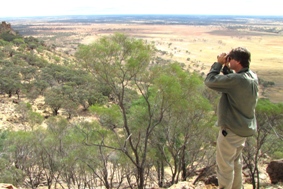Research programs
In order to make informed decisions about managing Queensland's natural resources, the department implements a range of research programs. These include:
- monitoring air, water and wetlands
- monitoring macropod populations to ensure a sustainable harvest of kangaroos
- research on plants, fungi, and ecological systems, undertaken by the Queensland Herbarium, including the Weed Spotters' Network Queensland.

Threatened species research and monitoring
The department conducts research and monitoring of a number of Queensland’s threatened plants and animals. Examples are:
- Koalas: the South East Queensland Koala Conservation Strategy details the Queensland Government’s plan to address the decline of koalas based on six action areas including improved mapping, monitoring, research and reporting.
- Northern hairy-nosed wombat: the Queensland Government has been monitoring the northern hairy-nosed wombat since the 1970s. This includes research into changes in wombat demographics and the health, breeding condition and survival of wombats.
- Marine turtles: Queensland has the longest history of marine turtle conservation and management in Australia, starting in the early 1930s. Priority actions in the Queensland Marine Turtle Conservation Strategy include research and monitoring to improve scientific understanding of marine turtle status, threats and management options. Satellite tracking devices help us understand where turtles go after nesting on Queensland beaches.
- Southern cassowary: a method for estimating southern cassowary abundance from genetic material in scats is being developed with CSIRO. These results may help estimate the size of the population, how far the birds move, as well as determine their breeding patterns.
- Greater bilby: ongoing research is conducted to better understand how greater bilby populations are changing over time. This involves trialling different survey methods including aerial, ground and drone burrow surveys, and thermal image camera and spotlight surveys of bilbies.
- Bushfire impacts: following unprecedented bushfires in 2019-20, surveys were undertaken in the Gondwana World Heritage Area , Cooloola section of Great Sandy National Park, Oakview National Park and Bulburin National Park to assess the impacts on threatened species.
The Research prospectus for Queensland threatened species and conservation estate priorities and opportunities identifies how scientific and research organisations can collaborate with the department and help address knowledge gaps.
Records of plant and animal locations are stored in the department’s WildNet database. Information is accessible through Species lists, Wetland Summary Information Search and WetlandMaps (Report Tool).
All research is conducted in accordance with the provisions of Queensland’s Animal Care and Protection Act 2001 and is monitored by the Department of Agriculture and Fisheries Animal Ethics Committee.


